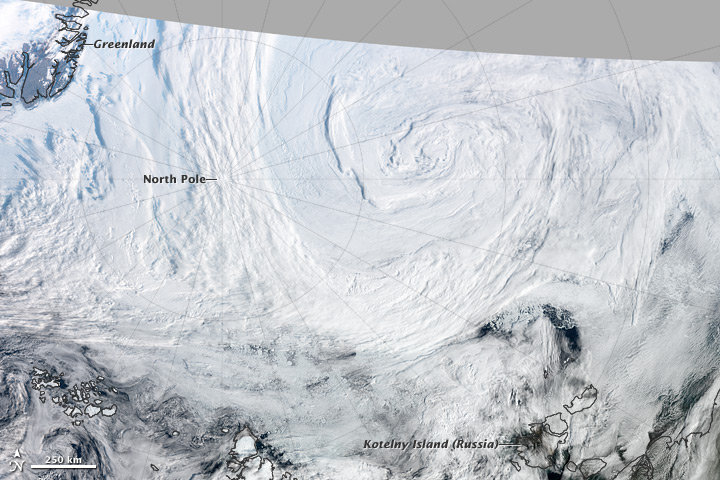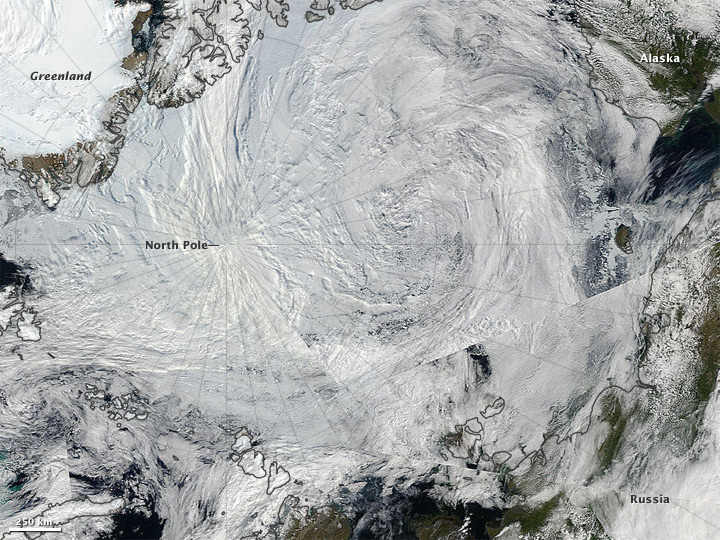acquired August 7, 2012
download large image (11 MB, JPEG, 6358x6362)
acquired August 7, 2012
download GeoTIFF file (66 MB, TIFF)
An unusually strong storm formed off
the coast of Alaska on August 5, 2012, and tracked into the center of
the Arctic Ocean, where it lingered for several days. The Moderate Resolution Imaging Spectroradiometer (MODIS) aboard the Aqua
satellite captured this natural-color image on August 7, 2012. The
center of the storm was located in the middle of the Arctic Ocean at the
time.
The storm had an unusually low central pressure area. “It’s an uncommon event, especially because it’s occurring in the summer,” said Paul Newman, chief scientist for atmospheric sciences at NASA’s Goddard Space Flight Center. “Polar lows are more usual in the winter.” Newman estimated that there have only been about eight storms of similar strength during the month of August over the past 34 years of satellite records.
“It seems that this storm has detached a large chunk of ice from the main sea ice pack,” said Claire Parkinson, a climate scientist at NASA Goddard who studies ice. “This could lead to a more serious decay of the summertime ice cover than would have been the case otherwise, even perhaps leading to a new Arctic sea ice minimum.”
Arctic storms can have a large impact on sea ice, causing it to melt rapidly. Storms can tear off large swaths of ice and push them to warmer sites; they can churn the ice and make it slushier; or they can pull warmer waters up from the depths of the Arctic Ocean. “Decades ago, a storm of the same magnitude would have been less likely to have as large an impact on the sea ice because the ice cover was thicker and more expansive,” Parkinson added.
The storm had an unusually low central pressure area. “It’s an uncommon event, especially because it’s occurring in the summer,” said Paul Newman, chief scientist for atmospheric sciences at NASA’s Goddard Space Flight Center. “Polar lows are more usual in the winter.” Newman estimated that there have only been about eight storms of similar strength during the month of August over the past 34 years of satellite records.
“It seems that this storm has detached a large chunk of ice from the main sea ice pack,” said Claire Parkinson, a climate scientist at NASA Goddard who studies ice. “This could lead to a more serious decay of the summertime ice cover than would have been the case otherwise, even perhaps leading to a new Arctic sea ice minimum.”
Arctic storms can have a large impact on sea ice, causing it to melt rapidly. Storms can tear off large swaths of ice and push them to warmer sites; they can churn the ice and make it slushier; or they can pull warmer waters up from the depths of the Arctic Ocean. “Decades ago, a storm of the same magnitude would have been less likely to have as large an impact on the sea ice because the ice cover was thicker and more expansive,” Parkinson added.
NASA image by Jeff Schmaltz, LANCE/EOSDIS Rapid Response. Caption by Maria-Jose Vinas.
- Instrument:
- Aqua - MODIS

acquired August 7, 2012
download large image (5 MB, JPEG, 6000x4000)
An unusually large, long-lasting, and
powerful cyclone was churning over the Arctic in early August 2012. Two
smaller systems merged on August 5 to form the storm, which at the time
occupied much of the Beaufort-Chukchi Sea and Canadian Basin. On
average, Arctic cyclones last about 40 hours; as of August 9, 2012, this
storm had lasted more than five days.
The Visible Infrared Imaging Radiometer Suite (VIIRS) on Suomi NPP captured this view of the storm on August 7, 2012. The Moderate Resolution Imaging Spectroradiometer (MODIS) aboard Aqua captured a natural-color image of the storm as well.
Arctic cyclones are more common during the summer than winter; however, summer cyclones tend to be weaker than the storms that batter the region during the winter. This cyclone’s central sea level pressure reached about 964 millibars on August 6, 2012—a number more typical of a winter cyclone. That pressure puts it within the lowest 3 percent of all minimum daily sea level pressures recorded north of 70 degrees latitude, noted Stephen Vavrus, an atmospheric scientist based at the University of Wisconsin.
The number of cyclones affecting the Arctic appears to be increasing. According to a study of long-term Arctic cyclone trends authored by a team led by John Walsh and Xiangdong Zhang of the University of Alaska Fairbanks, the number and intensity of Arctic cyclones has increased during the second half of the twentieth century, particularly during the summer.
The cause of the increase is an open question, but climate change may be affecting Arctic cyclones. One study published in Atmospheric and Oceanic Science Letters, concluded that the total number of exratropical cyclones in the Northern Hemisphere would decline as the climate changed, but that the Arctic Ocean and adjacent areas would see slightly more and stronger summer storms.
One way climate change may affect Arctic cyclones is by changing the sea ice and ocean temperature. Climate change has caused sea ice to retreat markedly in recent decades and has also warmed Arctic Ocean temperatures. Such changes may be providing more energy and moisture to support cyclone development and persistence, Zhang explained.
However, scientists who study extratropical storms emphasize that pinning down how exactly climate change is affecting the size, frequency, or tracks of Arctic storms remains an important but unresolved question. “This past week’s storm was exceptional, and the occurrence of Arctic storms of extreme intensity is a topic deserving closer investigation,” noted Walsh. “With reduced ice cover and warmer sea surfaces, the occurrence of more intense storms is certainly a plausible scenario. The limitation at present is the small sample size of exceptional events, but that may change in the future.”
The Visible Infrared Imaging Radiometer Suite (VIIRS) on Suomi NPP captured this view of the storm on August 7, 2012. The Moderate Resolution Imaging Spectroradiometer (MODIS) aboard Aqua captured a natural-color image of the storm as well.
Arctic cyclones are more common during the summer than winter; however, summer cyclones tend to be weaker than the storms that batter the region during the winter. This cyclone’s central sea level pressure reached about 964 millibars on August 6, 2012—a number more typical of a winter cyclone. That pressure puts it within the lowest 3 percent of all minimum daily sea level pressures recorded north of 70 degrees latitude, noted Stephen Vavrus, an atmospheric scientist based at the University of Wisconsin.
The number of cyclones affecting the Arctic appears to be increasing. According to a study of long-term Arctic cyclone trends authored by a team led by John Walsh and Xiangdong Zhang of the University of Alaska Fairbanks, the number and intensity of Arctic cyclones has increased during the second half of the twentieth century, particularly during the summer.
The cause of the increase is an open question, but climate change may be affecting Arctic cyclones. One study published in Atmospheric and Oceanic Science Letters, concluded that the total number of exratropical cyclones in the Northern Hemisphere would decline as the climate changed, but that the Arctic Ocean and adjacent areas would see slightly more and stronger summer storms.
One way climate change may affect Arctic cyclones is by changing the sea ice and ocean temperature. Climate change has caused sea ice to retreat markedly in recent decades and has also warmed Arctic Ocean temperatures. Such changes may be providing more energy and moisture to support cyclone development and persistence, Zhang explained.
However, scientists who study extratropical storms emphasize that pinning down how exactly climate change is affecting the size, frequency, or tracks of Arctic storms remains an important but unresolved question. “This past week’s storm was exceptional, and the occurrence of Arctic storms of extreme intensity is a topic deserving closer investigation,” noted Walsh. “With reduced ice cover and warmer sea surfaces, the occurrence of more intense storms is certainly a plausible scenario. The limitation at present is the small sample size of exceptional events, but that may change in the future.”
References
- Orsolini, Yvan. (2008, January 16). Projected Changes in Eurasian and Arctic Cyclones Under Global Warming in the Bergen Climate Model. Atmospheric and Oceanic Science Letters.
- Zhang, X. (2004, January 2004). Climatology and Interannual Variability of Arctic Cyclone Activity: 1948-2002. Journal of Climate.
Further Reading
- NASA. (2008, October 6). NASA Study Finds Rising Arctic Storm Activity Sways Sea Ice, Climate. Accessed August 9, 2012.
- NSDIC. (n.d.) Cyclones in the Arctic. Accessed August 9, 2012.
- New York Times. (2012, August 8). A Closer Look at Ice Impacts of a Rare Arctic Summer Storm. Accessed August 9, 2012.
- Tanaka, H.L. (2012, March, 2). The Structure and Behavior of the Arctic Cyclone in Summer Analyzed by the JRA-25/JCDAS Data. Polar Science.
- XWeather.org (n.d.). Arctic Cyclones. Accessed Aug 9, 2012.
NASA Earth Observatory
image by Jesse Allen and Robert Simmon, using VIIRS data. Caption by
Adam Voiland with information from Robert Walsh, Xiangdong Zhang, and
Stephen Vavrus.
- Instrument:
- Suomi NPP - VIIRS
NASA: North Pole - 2012 Arctic Cyclone - Strong Summer Cyclone Churns Over the Arctic
Ricardo M Marcenaro - Facebook
Operative blogs of The Solitary Dog:
solitary dog sculptor:
http://byricardomarcenaro.blogspot.com
Solitary Dog Sculptor I:
http://byricardomarcenaroi.blogspot.com
Para:
comunicarse conmigo,
enviar materiales para publicar,
propuestas:
marcenaroescultor@gmail.com
For:
contact me,
submit materials for publication,
proposals:
marcenaroescultor@gmail.com
Diario La Nación
Argentina
Cuenta Comentarista en el Foro:
Capiscum
My blogs are an open house to all cultures, religions and countries. Be a follower if you like it, with this action you are building a new culture of tolerance, open mind and heart for peace, love and human respect.
Thanks :)
Mis blogs son una casa abierta a todas las culturas, religiones y países. Se un seguidor si quieres, con esta acción usted está construyendo una nueva cultura de la tolerancia, la mente y el corazón abiertos para la paz, el amor y el respeto humano.
Gracias :)


No hay comentarios:
Publicar un comentario